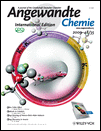Biotransformation on Polymer–Peptide Conjugates: A Versatile Tool to Trigger Microstructure Formation†
Hans Kühnle
Max Planck Institute of Colloids and Interfaces, Research Campus Golm, 14424 Potsdam (Germany), Fax: (+49) 331-567-9502 http://www.mpikg.mpg.de/kc/boerner/
Search for more papers by this authorHans G. Börner Dr.
Max Planck Institute of Colloids and Interfaces, Research Campus Golm, 14424 Potsdam (Germany), Fax: (+49) 331-567-9502 http://www.mpikg.mpg.de/kc/boerner/
Search for more papers by this authorHans Kühnle
Max Planck Institute of Colloids and Interfaces, Research Campus Golm, 14424 Potsdam (Germany), Fax: (+49) 331-567-9502 http://www.mpikg.mpg.de/kc/boerner/
Search for more papers by this authorHans G. Börner Dr.
Max Planck Institute of Colloids and Interfaces, Research Campus Golm, 14424 Potsdam (Germany), Fax: (+49) 331-567-9502 http://www.mpikg.mpg.de/kc/boerner/
Search for more papers by this authorThe work was supported by the Deutsche Forschungsgemeinschaft (Emmy Noether BO1762/2-3) and Max Planck Society. We thank M. Antonietti, A. Thomas, E. Krause, D. Gebauer, H. Stephanowitz, A. Heilig, R. Pitschke and A. E. F. Wächtler, M. Kühnle, and Erich C.
Graphical Abstract
At the flick of a switch: Introducing phosphate moieties into (Thr-Val)X peptide aggregation domains disturbs the formation of secondary structures. This suppression is used to regulate the self-assembly of polymer–peptide conjugates. A phosphatase enzyme which hydrolyzes the phosphate esters then triggers the self-assembly process generating fibrillar aggregates (see scheme).
Supporting Information
Detailed facts of importance to specialist readers are published as ”Supporting Information”. Such documents are peer-reviewed, but not copy-edited or typeset. They are made available as submitted by the authors.
| Filename | Description |
|---|---|
| anie_200805768_sm_miscellaneous_information.pdf3.3 MB | miscellaneous information |
Please note: The publisher is not responsible for the content or functionality of any supporting information supplied by the authors. Any queries (other than missing content) should be directed to the corresponding author for the article.
References
- 1
- 1aJ.-F. Lutz, H. G. Börner, Prog. Polym. Sci. 2008, 33, 1;
- 1bH.-A. Klok, J. Polym. Sci. Part A 2005, 43, 1;
- 1cJ. C. M. van Hest, Polym. Rev. 2007, 47, 63.
- 2
- 2aG. M. Whitesides, Small 2005, 1, 172;
- 2bH. G. Börner, H. Schlaad, Soft Matter 2007, 3, 394;
- 2cS. Förster, T. Plantenberg, Angew. Chem. 2002, 114, 712;
10.1002/1521-3757(20020301)114:5<712::AID-ANGE712>3.0.CO;2-V Google ScholarAngew. Chem. Int. Ed. 2002, 41, 688;
- 2dJ. C. M. van Hest, D. A. Tirrell, Chem. Commun. 2001, 1897.
- 3
- 3aH. Frauenrath, E. Jahnke, Chem. Eur. J. 2008, 14, 2942;
- 3bE.-K. Schillinger, E. Mena-Osteriz, J. Hentschel, H. G. Börner, P. Bäuerle, Adv. Mater. 2009, 21, 1562.
- 4
- 4aH.-A. Klok, H. Schlaad Adv Polym. Sci. 2006, 202, 160;
- 4bS. Tugulu, P. Silacci, N. Stergiopulos, H. A. Klok, Biomaterials 2007, 28, 2536;
- 4cJ. Hentschel, K. Bleek, O. Ernst, J.-F. Lutz, H. G. Börner, Macromolecules 2008, 41, 1073.
- 5
- 5aS. Kessel, A. Thomas, H. G. Börner, Angew. Chem. 2007, 119, 9181;
10.1002/ange.200703752 Google ScholarAngew. Chem. Int. Ed. 2007, 46, 9023;
- 5bM. G. Page, N. Nassif, H. G. Börner, M. Antonietti, H. Cölfen, Cryst. Growth Des. 2008, 8, 1792;
- 5cJ. Couet, J. D. Jeyaprakash, S. Samuel, A. Kopyshev, S. Santer, M. Biesalski, Angew. Chem. 2005, 117, 3361;
10.1002/ange.200462993 Google ScholarAngew. Chem. Int. Ed. 2005, 44, 3297;
- 5dL. Hartmann, S. Häfele, R. Peschka-Süss, M. Antonietti, H. G. Börner, Chem. Eur. J. 2008, 14, 2025.
- 6P. S. Stayton, T. Shimoboji, C. Long, A. Chilkoti, G. H. Chen, J. M. Harris, A. S. Hoffman, Nature 1995, 378, 472.
- 7T. S. Burkoth, T. L. S. Benzinger, V. Urban, D. G. Lynn, S. C. Meredith, P. Thiyagarajan, J. Am. Chem. Soc. 1999, 121, 7429.
- 8
- 8aM. Mutter, A. Chandravarkar, C. Boyat, J. Lopez, S. Dos Santos, B. Mandal, R. Mimna, K. Murat, L. Patiny, L. Saucede, G. Tuchscherer, Angew. Chem. 2004, 116, 4267;
10.1002/ange.200454045 Google ScholarAngew. Chem. Int. Ed. 2004, 43, 4172;
- 8bY. Sohma, M. Sasaki, Y. Hayashi, T. Kimura, Y. Kiso, Chem. Commun. 2004, 124.
- 9J. Hentschel, E. Krause, H. G. Börner, J. Am. Chem. Soc. 2006, 128, 7722.
- 10J. Hentschel, H. G. Börner, J. Am. Chem. Soc. 2006, 128, 14142.
- 11
- 11aP. M. Gallop, M. A. Paz, Physiol. Rev. 1975, 55, 418;
- 11bR. B. Rucker, C. McGee, J. Nutr. 1993, 123, 977;
- 11cJ.-H. Kim, S. Lee, K. Park, H. Y. Nam, S. Y. Jang, I. Y. K. Kim, H. Jeon, R.-W. Park, I.-S. Kim, K. Choi, I. C. Kwon, Angew. Chem. 2007, 119, 5881; Angew. Chem. Int. Ed. 2007, 46, 5779.
- 12
- 12aA. C. A. Roque, C. R. Lowe, Biotechnol. Bioeng. 2005, 91, 546;
- 12bM. Gallego, D. M. Virshup, Curr. Opin. Cell Biol. 2005, 17, 197.
- 13R. S. Signarvic, W. F. DeGrado, J. Mol. Biol. 2003, 334, 1.
- 14
- 14aZ. M. Yang, G. L. Liang, L. Wang, X. Bing, J. Am. Chem. Soc. 2006, 128, 3038;
- 14bR. J. Mart, R. D. Osborne, M. M. Stevens, R. V. Ulijn, Soft Matter 2006, 2, 822.
- 15K. Janek, J. Behlke, J. Zipper, H. Fabian, Y. Georgalis, M. Beyermann, M. Bienert, E. Krause, Biochemistry 1999, 38, 8246.
- 16
- 16aD. Eckhardt, M. Groenewolt, E. Krause, H. G. Börner, Chem. Commun. 2005, 2814;
- 16bA. Agelli, I. A. Nyrkova, M. Bell, R. Harding, L. Carrick, T. C. B. McLeish, A. N. Semenov, N. Boden, Proc. Natl. Acad. Sci. USA 2001, 98, 11857.
- 17M. S. Lamm, K. Rajagopal, J. P. Schneider, D. J. Pochan, J. Am. Chem. Soc. 2005, 127, 16692.
- 18
- 18aJ. D. Harper, P. T. Lansbury, Annu. Rev. Biochem. 1997, 66, 385;
- 18bF. E. Cohen, K. M. Pan, Z. Huang, M. Baldwin, R. J. Fletterick, S. B. Prusiner, Science 1994, 264, 530.





